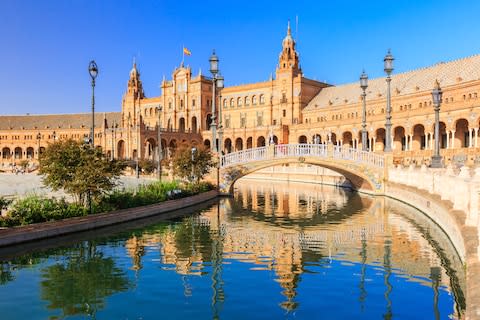Why this Andalusian gem is Europe's greatest city in winter
Jeanette Winterson was not, of course, using the title of her 1985 novel as a statement about the diversity of orchards and citrus groves. But as I inch around the edge of the Plaza Virgen de los Reyes on a warm afternoon, I begin to doubt her suggestion that oranges are not the only fruit. They are everywhere in this pivotal Seville square, to the seeming exclusion of anything else organic, the trees – under whose limbs the city’s famous horses and carriages pause to rest – dotted with swollen baubles of tangy fertility.
Their aroma fills the air. Harvest is nearing, with all its promises of juice, pulp and marmalade, and the scent of oranges on the verge of ripeness ripples – so much so that, six minutes later, when I have gained the rooftop bar of the adjacent Hotel Do?a María, it still reaches my nose, four floors up. At a table overlooking the plaza, a group of friends is slipping through a woozy Saturday with wine and short sleeves while, opposite, the Giralda, the inimitable Unesco-listed bell tower of Seville Cathedral, bathes in a wash of sunshine. I check my phone, and the date, again. It really is November.
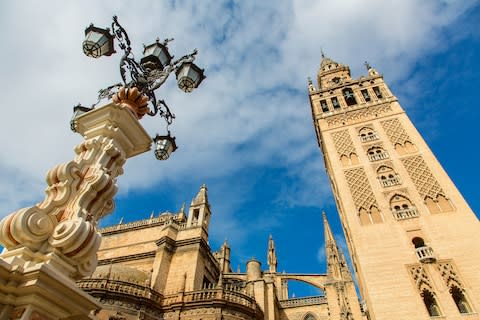
Pay a visit to Andalusia towards the end of the year and you might wonder whether its capital bothers with winter. The coldest season is rarely apparent in the 11th month, the temperature clinging to a fine and pleasant 20C. And even if it drops a little, to a still-gentle 16C, between December and February, it has usually regained its glow by March.
But then, this is no outlandish announcement. Popular perception might view Seville as defined by its Moorish past – the Alcázar palace singing of the five-century period (712-1248) when southern Spain was ruled by North African sultans, and the size of the Giralda being partially an attempt to disguise the fact that it was once a minaret. Yet the city is shaped far less by its Arabic heritage than it is by its relationship with the sun. It has learnt to cope with the anger of a celestial tyrant whose ire can crest 40C in midsummer. It cowers in corners, begs mercy of shadows – to the extent that, even in November, it hides from the heavens.
In any other city, the idea of a vast installation blocking out the sky in a significant public space would surely cause howls of disgust. In Seville, it just seems an act of pragmatism. The clue is there in the name, because the official title of the modernist masterpiece that spans much of Plaza de la Encarnación (the creation of German architect Jürgen Mayer) is the “Metropol Parasol” (even if Sevillanos tend to call it “Las Setas”, meaning “Mushrooms”). It stretches out as a slatted-wood canopy 230ft wide and 490ft long, a daring fragment of 2011 thrillingly out of kilter with the 16th-century Iglesia de la Anunciación, which watches, unamused, from the south-west flank of the square. In July and August, the city shelters underneath it, grateful for the respite it provides from the incessant heat.

November, though, brings a different picture. Evidence that this may be the ideal month to drop anchor in Seville is there at the restaurants under the fringes of the Parasol, locals gathered at outdoor tables, gnawing at delicate plates of sashimi at Japanese venue Bushi, and contemplating the cocktail list at next-door style-bar Moss. In a sense, all Sevillano life is here – inside the squat structure that underpins Mayer’s artistry, the Mercado de la Encarnación deals in thick haunches of tuna on marble slabs, as well as the inevitable prisms of oranges; beneath it, the Antiquarium museum recalls the Seville that existed in Roman times, as “Hispalis”. I delve into the latter, admiring the laurel-leaf mosaics that linger in the floor of the fourth-century villa Casa de las Columnas. The view of the city from the top of the Parasol shows it as a flat expanse of ruddy brick – as if the sun, over tireless centuries, has pounded it into the soil.
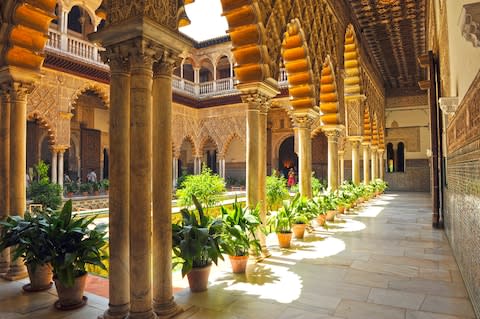
It also shows it as a maze of squished contours, where one district runs distractedly into another. So it proves where the broader spaces of Centro ebb east and collide with the narrower alleys and scruffier confines of residential La Macarena. Here, suddenly, is less room to breathe than on the south side of Seville, where the Parque de Maria Luisa is a 100-acre lung. But there is invention too. The Palacio de las Due?as slots itself onto the thin thoroughfare of Calle Due?as, skulking behind its mighty gateway as a home of the Duke of Alba. Built in the 15th century, but opened to the public only in 2016, it provides an architectural masterclass in how to keep one’s cool. Its central courtyard is a delight – Andalucia incarnate in its Moorish flourishes, elegant cloisters and tinkling fountain – a giant palm tree rising to shield visitors from white-hot middays. Beyond, the Lemon Tree Garden (El Jardín de los Limoneros) is so lovely that it is eulogised in verse. The poet Antonio Machado, born in the palace in 1875, wrote that “my childhood is a memory of a patio in Seville, and a bright orchard where the lemon tree grows”. Over 140 years on, the image is intact – leaves fluttering in an oasis at the heart of Spain’s fourth-biggest city.
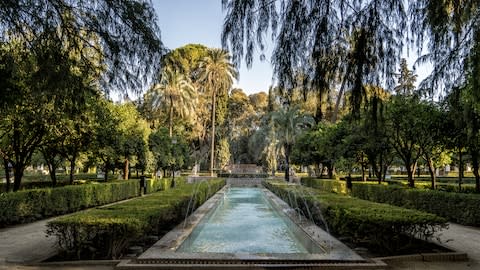
If Seville is feeling brave in even-tempered November – there are more al fresco chairs and conversations along La Macarena’s bar-drag Calle Feria, and around the colossal plaza of Alameda de Hércules, where tapas restaurants hold court – there are further signs of its eternal struggle with the sun. All along the retail avenue of Calle Sierpes, white drapes are strung between the buildings at roof level – canvas guardians protecting the shoppers below. Calles Rioja, Rosario, O’Donnell and Tetuán are similarly enhanced and, together, they create a labyrinth of covered walkways that seems to mimic the souks of Marrakesh. The echo is appropriate as Sierpes funnels me south into the arms of North Africa – the Alcázar smiling as Seville’s key example of a building designed to withstand the weather.
In part, the smile conceals a lie. While the palace was certainly founded in the Moorish era – and plays up to these origins in its sighing arches and alcoves – much of its fabric dates to the 14th century, when the Spanish crown had seized control. It was Pedro I who commissioned the iconic Patio de las Doncellas, with its long reflecting pool, pale marble walls and shaded perimeter – acknowledging not just the beauty of the former regime’s style of construction, but also its pragmatic benefits. Even in November, it feels noticeably colder inside the courtyard, as if the sun cannot penetrate this haven for kings and queens.
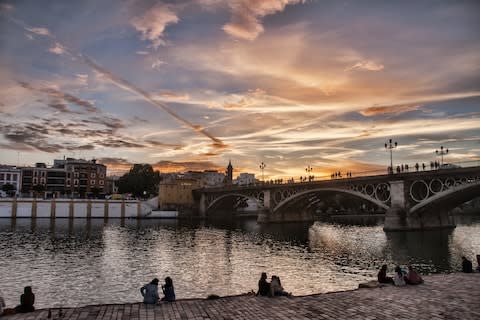
Beyond the walls of the Alcázar, drifting away to the west, Seville meets the flow of the Guadalquivir (technically the Canal de Alfonso III, a side-branch of a river that dissects the city in two channels), and changes pace. On the far side of the soupy green currents, Triana keeps its own counsel – not so much a neighbourhood as an outlying enclave, imbued with its own attitude and identity. It has traditionally been a place of sailors and dockers, calloused hands pulling at ropes – 300m and yet a world away from the sophisticates and perfumed courtiers of Centro. But if some of its coarseness has been leavened by money and modernity, its togetherness is still visible on the hard line of Calle Pelay Correa as it runs parallel to the water. Midway along, two adjoining tapas bars, Bar Bistec and Bodega Siglo XVIII, duel for customers, their wares imprinted on chalkboards – sardines and prawns, anchovies, squid, salt-cod. The rivalry, though, is friendly, the crowd outside spilling evenly through both doorways, the tiled floors inside covered with discarded napkins and cocktail sticks. A Sunday fiesta is in motion, pinned to the Iglesia de Santa Ana, opposite – a celebration on the street, in spite of the date on the calendar. And there is that colour once more, the walls of the church an undiluted orange.
A block north, Calle Pureza carries me west, past cycle workshops and square-cut houses – until, on Plaza del Altozano, Triana embraces its gentrification. Opened in 1823, the Mercado de Triana must once have been a workhorse, a slurry of fish guts and manual labour. Now it deals in weeknight cookery classes at the Taller Andaluz de Cocina, and in those ubiquitous oranges – even if, these days, they are present at Bocasú, a patisserie where foodsmith Manuel Jara crafts chou-pastry nuggets, glazed and filled with custard, in a rainbow of flavours – apple and raspberry, as well as clementine.
A little further back in the market, another outlet is selling Christmas gifts. These are cute trinkets and wood toys, but the display is dusted with fake snow – and, momentarily, the incongruity makes me laugh. In Seville, the concept of a frosty winter is so implausible that it has to be fabricated.
Getting there
British Airways (0344 493 0787; ba.com), easyJet (0330 365 5000; easyjet.com) and Ryanair (0871 246 0000; ryanair.com) all fly to Seville.
See our guide to the best hotels in Seville
